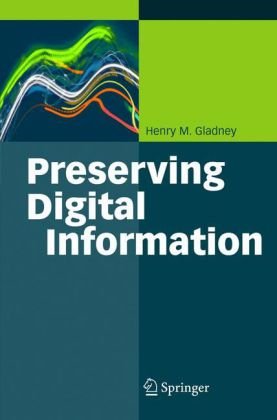

Most ebook files are in PDF format, so you can easily read them using various software such as Foxit Reader or directly on the Google Chrome browser.
Some ebook files are released by publishers in other formats such as .awz, .mobi, .epub, .fb2, etc. You may need to install specific software to read these formats on mobile/PC, such as Calibre.
Please read the tutorial at this link: https://ebookbell.com/faq
We offer FREE conversion to the popular formats you request; however, this may take some time. Therefore, right after payment, please email us, and we will try to provide the service as quickly as possible.
For some exceptional file formats or broken links (if any), please refrain from opening any disputes. Instead, email us first, and we will try to assist within a maximum of 6 hours.
EbookBell Team

4.4
92 reviews
ISBN 10: 3540378863
ISBN 13: 9783540378860
Author: Henry Gladney
Cultural history enthusiasts have asserted the urgent need to protect digital information from imminent loss. Without action, much of what has been created in digital form is likely to become unusable. Although a decade has already elapsed since this challenge was clearly articulated, nobody has described a complete procedure for preventing such loss – until now.
Leading industry consultant Henry M. Gladney outlines a technical solution and justifies its correctness and optimality. His presentation focuses on long-term digital preservation principles as a basis for producing the software that will be needed. The method described will work for any kind of digital document, multimedia file, business record collection, or scientific information, and is believed to be optimal with respect to both the quality of the preserved information and end-user convenience. Additionally, Dr. Gladney explains the requirements of the related software, and sketches how to implement it.
Preserving Digital Information presents an up-to-date description of its field, together with a solution for all technical problems identified in the pertinent professional literature. It is for archivists, research librarians, and museum curators who need to understand digital technology in order to manage their institutions; software engineers and computer scientists whose work requires sound information about digital preservation; and attorneys, medical professionals, government officials, and business executives who depend on the long-term reliability of digital records.
Part I: Foundational Concepts and Models
Chapter 1: The Problem of Digital Obsolescence
Chapter 2: Defining Digital Preservation
Chapter 3: Understanding Digital Objects
Part II: The Digital Preservation Lifecycle
Chapter 4: Ingest: Bringing Content into the Archive
Chapter 5: Archival Storage and Security
Chapter 6: Data Management and Administration
Chapter 7: Preservation Planning
Chapter 8: Access and Dissemination
Part III: Technical Strategies and Practical Tools
Chapter 9: The Migration Strategy
Chapter 10: The Emulation Strategy
Chapter 11: Ensuring Integrity and Authenticity
Chapter 12: File Formats for Preservation
Part IV: Organizational and Management Issues
Chapter 13: The Economics of Digital Preservation
Chapter 14: Governance, Policy, and Staffing
Chapter 15: Building a Trusted Digital Repository
Part V: Specialized Content and Future Directions
Chapter 16: Preserving Complex Digital Objects
Chapter 17: Emerging Trends and Technologies
preserving digital information
preserving access to digital information
what is the role of digital libraries in preserving information
what are digital best practices for information preserving and sharing
what is the best way to store digital information
Tags: Henry Gladney, Preserving, Digital